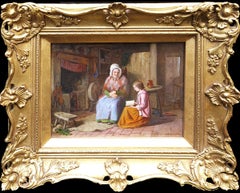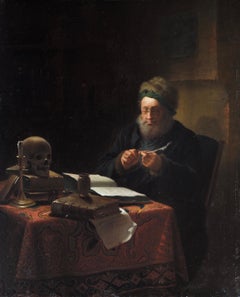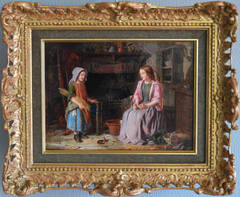James Hardy Jr. Art
British, 1832-1889
James Hardy Jnr was a popular Victorian artist who lived in Bristol. He jumped aboard the Balmoral bandwagon driven by Landseer, to produce many Scottish sporting scenes in which live animals, tended by ghillies, predominating over the dead bag. Both figures and landscape settings were painted well enough and bore such titles as On the Moors or Tying up the Game. He exhibited at the Royal Academy between 1862 and 1886, as well as at the British Institution, Suffolk Street and the New Watercolour Society. The artist became an associate of the New Watercolour Society in 1874 and was made a full member in 1877. Hardy’s subjects were landscapes with rustic figures, hunting scenes, still lifes and genre scenes or interiors. He is also known to have painted dogs with game. Sales of his works were held at Christies on 9 March 1878 and also after his death on 4th April 1889.(Biography provided by Anthony Woodd Gallery)
to
1
1
1
1
Overall Height
to
Overall Width
to
1
1
1
1
1
1
6,952
3,301
2,514
1,213
1
1
1
Artist: James Hardy Jr.
Reading to Grandma
By James Hardy Jr.
Located in Belgravia, London, London
Oil on panel
Panel size: 6 x 8 inches
Framed size: 10.25 x 12.25 inches
Signed and date '1860' lower right
Category
19th Century James Hardy Jr. Art
Materials
Oil, Panel
Related Items
Gotich style Florentine painter - 19th century figure painting - Virgin Child -
Located in Varmo, IT
Florentine painter (19th century) - Madonna with Child on a gold background.
77 x 58 cm.
Oil on polylobed panel.
Condition report: Good state of conservation of the pictorial surf...
Category
Late 19th Century Gothic James Hardy Jr. Art
Materials
Oil, Panel
Scholar Sharpening His Quill Penn Attributed to Justus Juncker, Oil on Panel
Located in Stockholm, SE
Justus Juncker (1703-1763, Germany) Attributed to
Scholar Sharpening His Quill Penn
Expertise: We would like to thank Dr. Fred G Meijer for his valuab...
Category
Early 18th Century Old Masters James Hardy Jr. Art
Materials
Oil, Oak, Panel
Free Shipping
H 11.82 in W 9.45 in
17th century European oil, Christ and his disciples seated around a table.
Located in Woodbury, CT
17th century European oil, Christ and is disciples seated around a table.
An interesting and very unique painting.
Possibly a fragment originally from a piece of furniture.
The s...
Category
1650s Old Masters James Hardy Jr. Art
Materials
Wood Panel, Oil
Free Shipping
H 11.5 in W 27 in
Le Cafe de la Place Blanche - Post Impressionist Oil, Figures by Elie Pavil
By Elie Anatole Pavil
Located in Marlow, Buckinghamshire
Signed figures in interior oil on panel circa 1915 by Russian-born post impressionist painter Elie Anatole Pavil. The piece depicts a couple in the famous "White Cross" cafe at the P...
Category
1910s Post-Impressionist James Hardy Jr. Art
Materials
Oil, Panel
Behind Pretty Things (2022), oil on wood panel, portrait, patterns, faux naif
By Max Vesuvius Budnick
Located in Jersey City, NJ
Behind Pretty Things (2022), oil on wood panel painting by Max Vesuvius Budnick, portrait, patterns, faux naif
Classic faux naif portrait and interiors oil painting by Max Vesuvius Budnick. The artist cannot resist painting an appealing pattern and loves to render them by hand. In this painting he renders the ribbed pattern of his green corduroy hat, the tropical jungle motif of his bandana neckerchief complete with tropical birds, the tropical palm leaf pattern of his cell phone case, the blue stripe pattern of his button down shirt and the purple gradient of the walls behind him as he poses for a selfie in the mirror. His red beard peeks out from behind his bandana and on the wall behind him is a framed print of the painting, "Floral Still Life," by WWI veteran and African American artist, Horace Pippin...
Category
2010s Contemporary James Hardy Jr. Art
Materials
Oil, Wood, Wood Panel
H 17.5 in W 13.5 in D 1.75 in
"Playing hide and seek", 19th Century Oil on Panel by Vicente Palmaroli, Spanish
Located in Madrid, ES
VICNTE PALMAROLI y GONZÁLEZ
Spanish, 1834 - 1896
PLAYING HIDE AND SEEK
signed "V. Palmaroli" (lower right)
oil on mahogany panel
17-3/4 x 13-1/2 inches (45 X 34 cm.)
framed: 25-1/4 X 21-1/4 inches (64 X 53.7 cm.)
PROVENANCE
Leslie Hindman Inc., Auctionners
Private Collector, Madrid
Oil on table by Vicente Palmaroli...
Category
Late 19th Century Romantic James Hardy Jr. Art
Materials
Oil, Wood Panel
Dedale
By Jan Frans Deboever
Located in West Hollywood, CA
Belgian Symbolist artist Jan Frans DeBoever (1872 - 1948), created symbolist/allegorical paintings throughout his lifetime. He centralized on allegorical and literary subjects, gener...
Category
1920s Symbolist James Hardy Jr. Art
Materials
Panel, Oil
Yarn Spinner, in the manner of Pietro Longhi
Located in Cotignac, FR
Early 19th century oil on panel portrait of a young girl spinning.
Pietro Longhi was a Venetian painter who mastered the portrayal of scenes of everyda...
Category
19th Century Rococo James Hardy Jr. Art
Materials
Oil, Wood Panel
Old Men with Kittens - Impressionist Oil, Figures in Interior by J F Raffaelli
By Jean-Francois Raffaelli
Located in Marlow, Buckinghamshire
A wonderful oil on panel by French impressionist painter Jean-Francois Raffaelli depicting two old men seated in an interior. One is reading his paper as the other naps and there are several kittens on the floor. Painted in the artist's distinctive style. The work is accompanied by a certificate from Brame & Lorenceau and is included in the catalogue raisonne of the painter.
Signature:
Signed lower left
Dimensions:
Framed: 9.5"x8"
Unframed: 5.5"x4"
Provenance:
Private collection - United States
Original artists label verso
Jean-François Raffaëlli's father was a failed Italian businessman and Raffaëlli himself was, among other things, a church chorister, actor and theatre singer. He then studied under Gérôme at the École des Beaux-Arts in Paris. He travelled to Italy, Spain and Algeria and on his return to France settled in Asnières.
In 1876, on a trip to Brittany, he first saw the potential of realist subject matter, if treated seriously. He became involved in meetings of artists at the Café Guerbois, where the Impressionist painters used to gather. As a result, Degas, contrary to the advice of the group, introduced Raffaëlli to the Impressionist exhibitions - according to one uncertain source as early as the very first exhibition, at the home of Nadar, and certainly to those of 1880 and 1881.
In 1904, Raffaëlli founded the Society for Original Colour Engraving. He first exhibited at the Salon de Paris in 1870 and continued to exhibit there until he joined the Salon des Artistes Français in 1881, where he earned a commendation in 1885, was made Chevalier of the Légion d'Honneur in 1889 and in the same year was awarded a gold medal at the Exposition Universelle. In 1906 he was made Officier of the Légion d'Honneur. He was also a member of the Société Nationale des Beaux-Arts. In 1884, a private exhibition of his work cemented his reputation.
He contributed to several newspapers such as The Black Cat (Le Chat Noir) in 1885 and The French Mail (Le Courrier Français) in 1886 and 1887. He published a collection entitled Parisian Characters, which captured his favourite themes of the street, the neighbourhood and local people going about their lives. In 1880 he participated, with Forain, on the illustration of Joris Karl Huysmans' Parisian Sketches (Croquis Parisiens). He also illustrated Huysman's Works. As well as working as an illustrator, he also made etchings and coloured dry-points.
His early attempts at painting were genre scenes, but once he was settled in Asnières he started to paint picturesque views of Parisian suburbs. From 1879 onwards, his subject matter drew on the lives of local people. These popular themes, which he treated with humanity and a social conscience, brought him to the attention of the social realist writers of the time such as Émile Zola. In addition to his realist style, Raffaëlli's dark palette, which ran contrary to the Impressionist aesthethic, helped to explain the opposition of those painters to his participation in their exhibitions. More concerned with drawing than colour, he used black and white for most of his paintings. Towards the end of his life, he lightened his palette, but without adopting any other principles of the Impressionist technique.
After painting several portraits, including Edmond de Goncourt and Georges Clémenceau, he returned to genre painting, particularly scenes of bourgeois life. Later in his career, he painted mainly Breton-inspired sailors and views of Venice. His views of the Paris slums and the fortifications, sites which have almost completely disappeared, went some way towards establishing a genre in themselves and perpetuated the memory of the area: The Slums, Rag-and-Bone Man, Vagabond, Sandpit, In St-Denis, Area of Fortifications. His realistic and witty portrayal of typical Parisian townscapes accounts for his enduring appeal.
Born in Paris, he was of Tuscan descent through his paternal grandparents. He showed an interest in music and theatre before becoming a painter in 1870. One of his landscape paintings was accepted for exhibition at the Salon in that same year. In October 1871 he began three months of study under Jean-Léon Gérôme at the École des Beaux-Arts in Paris; he had no other formal training.
Raffaëlli produced primarily costume pictures until 1876, when he began to depict the people of his time—particularly peasants, workers, and ragpickers seen in the suburbs of Paris—in a realistic style. His new work was championed by influential critics such as J.-K. Huysmans, as well as by Edgar Degas.
The ragpicker became for Raffaëlli a symbol of the alienation of the individual in modern society. Art historian Barbara S. Fields has written of Raffaëlli's interest in the positivist philosophy of Hippolyte-Adolphe Taine, which led him to articulate a theory of realism that he christened caractérisme. He hoped to set himself apart from those unthinking, so-called realist artists whose art provided the viewer with only a literal depiction of nature. His careful observation of man in his milieu paralleled the anti-aesthetic, anti-romantic approach of the literary Naturalists, such as Zola and Huysmans.
Degas invited Raffaëlli to participate in the Impressionist exhibitions of 1880 and 1881, an action that bitterly divided the group; not only was Raffaëlli not an Impressionist, but he threatened to dominate the 1880 exhibition with his outsized display of 37 works. Monet, resentful of Degas's insistence on expanding the Impressionist exhibitions by including several realists, chose not to exhibit, complaining, "The little chapel has become a commonplace school which opens its doors to the first dauber to come along."An example of Raffaëlli's work from this period is Les buveurs d'absinthe (1881, in the California Palace of Legion of Honor Art Museum in San Francisco). Originally titled Les déclassés, the painting was widely praised at the 1881 exhibit.
After winning the Légion d'honneur in 1889, Raffaëlli shifted his attention from the suburbs of Paris to city itself, and the street scenes that resulted were well received by the public and the critics. He made a number of sculptures, but these are known today only through photographs.[2] His work was also part of the painting event in the art competition at the 1912 Summer Olympics. In the later years of his life, he concentrated on color printmaking. Raffaëlli died in Paris on February 11, 1924
Museum and Gallery Holdings:
Béziers: Peasants Going to Town
Bordeaux: Bohemians at a Café
Boston: Notre-Dame; Return from the Market
Brussels: Chevet of Notre-Dame; pastel
Bucharest (Muz. National de Arta al României): Market at Antibes; Pied-à-terre
Copenhagen: Fishermen on the Beach
Douai: Return from the Market; Blacksmiths
Liège: Absinthe Drinker...
Category
1890s Impressionist James Hardy Jr. Art
Materials
Panel, Oil
Interior with iMac and Venetian Chandelier, Single Female Figure, Oil Painting
By Andrew S. Conklin
Located in Chicago, IL
In his painting entitled "Interior with iMac and Venetian Chandelier", Andrew Conklin uses a loose paint brush to capture the scene. The interior scene shows a woman seated at a cloth covered table working on an early version iMac computer. Above her is an elaborate Venetian glass chandelier giving the interior an elegant feel. A vintage framed poster...
Category
21st Century and Contemporary Contemporary James Hardy Jr. Art
Materials
Panel, Oil
"The Painter and his Model", 19th C. Oil on Mahogany Wood Panel by E. L. Garrido
By Eduardo Leon Garrido
Located in Madrid, ES
EDUARDO LEÓN GARRIDO
Spanish, 1856- 1949
THE PAINTER AND HIS MODEL
signed "E. L Garrido" (lower right)
oil on mahogany wood panel
19-3/4 x 24-1/8 inches (50 x 61 cm.)
framed: 28-1/2 x 32-3/4 inches (72 x 83 cm.)
PROVENANCE
Private Spanish Collector
Eduardo León Garrido (Madrid, 1856 - Caen, 1949) was a Spanish painter. He began his training at the Higher School of Painting in Madrid and as a disciple in Vicente Palmaroli...
Category
Early 1900s Realist James Hardy Jr. Art
Materials
Wood Panel, Oil
The Hat Shop
By Donald S. Vogel
Located in Dallas, TX
Donald Vogel’s paintings reflect his interest in seeking beauty in life and in sharing pleasure with his viewers. Vogel entreats us to "rejoice and celebrate each new day, knowing it...
Category
1970s American Impressionist James Hardy Jr. Art
Materials
Panel, Oil
Previously Available Items
Preparing Supper, oil on panel
By James Hardy Jr.
Located in Nr Broadway, Worcestershire
James Hardy Junior
British, (1832-1889)
Preparing Supper
Oil on panel, signed & dated ‘60
Image size: 5½ inches x 7½ inches
Size including f...
Category
19th Century Victorian James Hardy Jr. Art
Materials
Oil, Panel
James Hardy Jr. art for sale on 1stDibs.
Find a wide variety of authentic James Hardy Jr. art available for sale on 1stDibs. You can also browse by medium to find art by James Hardy Jr. in oil paint, paint, panel and more. Not every interior allows for large James Hardy Jr. art, so small editions measuring 13 inches across are available. Customers who are interested in this artist might also find the work of William Shayer Senior, Adolphus Knell, and George Armfield. James Hardy Jr. art prices can differ depending upon medium, time period and other attributes. On 1stDibs, the price for these items starts at $8,300 and tops out at $12,104, while the average work can sell for $10,202.



